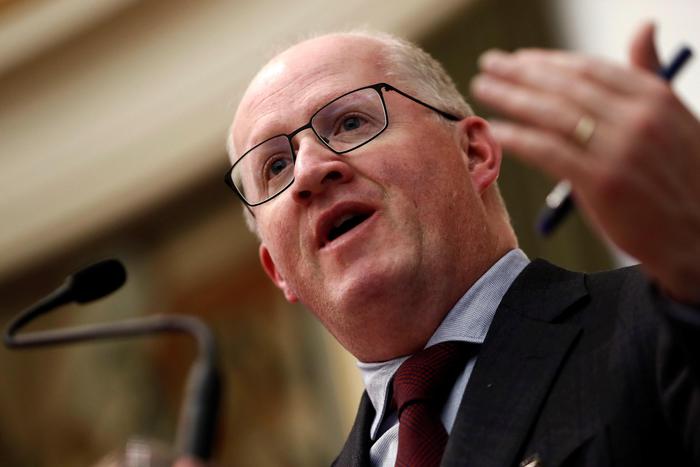Enlarge image
Fed Chairman Jerome Powell: First of all, wait until the “maximum employment level” has been reached
Photo: Graeme Jenning / dpa
Central bankers can be wrong, and quite dramatically.
The history of money has several such episodes in store for warning and deterrence.
We could learn a lot from it today.
One of the tragic figures in monetary history is Arthur Burns: a respected economist, a highly qualified professional who had previously served as a high-ranking advisor to American presidents. In 1970 he became head of the US Federal Reserve and presided over rising inflation rates for two terms, an era that would later go down in economic history as the "Great Inflation".
Exactly 50 years ago, in July 1971, Burns was at a congressional hearing reporting on the failures in fighting inflation.
“A year or two ago” it was “generally expected” that the “inflation spiral” would be slowed down.
However: "That did not happen, neither here nor abroad." At that time consumer prices rose at an annual rate of four and a half percent.
In the years that followed, inflation continued to rise.
In 1974 the rate was 11 percent; at the end of the decade it was even higher at times.
But Burns was no longer in office.
How could it come to this?
In the 1970s, the Fed was seen as a monetary authority that was at the cutting edge of economic knowledge. She had gathered clever people who used all the theories and methods that were popular at the time, who looked closely at the data and made all sorts of predictions. “Still, the economic results were disastrous,” said the economist Athanasios Orphanides, who wrote a number of research papers on the failure of the Fed in the 1970s.
Back then, the US Federal Reserve wanted to pursue a forward-looking monetary policy, and it had clear goals in mind: an inflation rate of two percent and a growing economy with low unemployment.
It all sounds reasonable - and strangely familiar.
Inflation rates somewhere around two percent and the highest possible level of employment, these are the goals of the US Federal Reserve today.
Arthur Burns' successors will meet
Wednesday
to discuss further course.
At a hearing in the Senate last week, the current Fed chairman Jerome Powell stated that the Fed wanted to keep interest rates at the extremely low level of just above zero and wait until the "maximum employment level" had been reached.
However, at an annual rate of 5.4 percent, the US inflation rate recently rose significantly faster than the Fed's target.
There were 9.2 million vacancies in the United States at the end of May.
House prices and rents are skyrocketing, and used cars are rapidly becoming more expensive.
One could read from the data that the economy has long been running hot and that inflation threatens to rise further.
The Fed, however, is relaxed: rates would soon fall again.
Special factors after the corona crisis would cause temporary price increases that would recede after a transitional phase.
You have to continue to pump massive amounts of money into the system in order to finally overcome the crisis.
Maybe Powell and his people are right.
Or maybe they are just as wrong as their predecessors half a century ago.
The sheikhs' fault?
In the 1970s, the US Federal Reserve looked at the unemployment rate with awe.
The economists' estimates said that a rate of four to five percent could be achieved without inflation rising.
Only below this threshold would the labor shortage drive wages up;
only then would companies add the higher labor costs to prices.
Because the measured unemployment rate was well above this value, the Fed assumed at the time that there must be a lot of unused production capacity in the USA.
From this she concluded that interest rates could be kept comparatively low without increasing inflation.
If prices rose anyway, then there would have to be other, "non-monetary" reasons that are beyond the control of the central bank.
Rising oil prices were an obvious reason: After the petro-cartel Opec had shown its teeth for the first time in 1973 and drastically increased the oil price, the West had to contend with rising energy costs.
The view that America was suffering from external "cost pressures" was widespread at the time, including in the US media, as the economist Edward Nelson has shown.
If the Fed makes mistakes, it will be felt worldwide.
A mistake.
Because, in fact, the economic structures had changed, unnoticed by the central bankers.
As later analyzes would show, the inflation threshold had shifted significantly.
In particular, structural unemployment rose.
The result: the central bank kept interest rates too low, spurred inflation on, without unemployment falling to the targeted ideal level.
There is a good deal of tragedy in this.
Because the Fed did not act in this way out of ignorance, but in accordance with the data that were available to it at the time.
Sure, in hindsight you are smarter.
Orphanides has calculated that the US Federal Reserve should actually have raised interest rates earlier and more strongly.
But because she underestimated the price dynamics and overestimated the job potential of the US economy, she was repeatedly surprised by far higher inflation rates without unemployment falling.
Is history repeating itself now?
The answers to this question go well beyond the United States.
The Fed is still the most influential central bank in the world.
Other monetary authorities are following their course.
If the Fed makes mistakes, it will be felt worldwide.
When wiping out the notch
The Fed is currently working on the basis of a monetary policy narrative that goes something like this: The currently relatively high inflation rates are a temporary phenomenon.
Rising prices are due to the corona crisis and the associated temporary production bottlenecks.
This problem will soon recede on its own.
The prevailing opinion at the moment is that the European Central Bank (ECB) is saying very similar things.
The financial markets have also believed this story so far.
more on the subject
Inflation worries: The fairy tale of stable money by Henrik Müller
The Fed's main concern is the labor market, as the detailed analyzes in its latest monetary policy report show. The Washington Monetary Authority looks not only at the number of those who are looking for a job, i.e. officially unemployed, but also at those who are currently not available for the job market. And these numbers are still well below the pre-Corona levels. The Fed, it looks like, will do everything it can to wipe out this gap and to increase the employment rates of as many sections of the population as possible as if the pandemic had never happened.
There is nothing wrong with the goal per se.
Luring people into the labor market contributes to individual well-being and social stability.
In addition, it is part of the Fed's legal mandate to ensure not only monetary stability, but also high employment levels - unlike the ECB, which is primarily obliged to maintain price stability under the EU treaty.
Still, the question arises as to whether the Fed is not repeating the mistakes of the 1970s.
Full throttle into the smoke screen
In fact, the US Federal Reserve has an employment target now, as it was then.
As long as the employment rate remains below pre-Corona values, according to this logic there must be unused production capacities in the economy.
An ample supply of money would therefore be able to reactivate all these unemployed and underutilized production capacities.
Can be right.
Can also go wrong.
Perhaps lower employment is the new normal.
Perhaps in retrospect we will find that the economic and employment structures have changed massively in the wake of the corona pandemic, similar to what was the case in the 1970s.
We do not know it.
more on the subject
Fear of inflation: Hui Buh, the inflation specter by Michael Brächer
Central banking is the art of navigating the fog of uncertainty, armed with rather imprecise instruments.
The ads can be deceiving.
Central banks use a wide range of data to determine their position.
It becomes problematic when they try to head for several goals at the same time - and when they are too convinced of their own ability to recognize the true state of the economy in real time.
The Fed's biggest mistake in the 1970s was to focus monetary policy on the "elusive goal of full employment," says Orphanides.
It would have been better just to worry about containing inflation.
It will be interesting to see how the dollar story ends this time.
The most important business dates of the week ahead
Open assembly area
Rome -
Eat for the World
- UN Food and Nutrition Summit.
Munich -
German Economy
- The Ifo Institute presents the new business climate index, the most important leading indicator for German economic development.
Reporting Season I
- Business figures from Philips, Michelin, LVMH, Lagardere, Faurecia, Ryanair, Tesla, Lockheed Martin.
Expand Tuesday area
Washington -
Trump's hooligans
- First hearing of the committee of inquiry into the storming of the Capitol on January 6th, which the then US president orchestrated from his speaker's platform.
Reporting season II
- business figures from Deutsche Börse, ACS, Dassault Systemes, Randstad, Reckitt Benckiser, Endesa, Alphabet, Microsoft, Visa, Apple, Starbucks, UPS, General Electric, 3M.
Expand Wednesday area
Washington -
Course determination
- The Federal Reserve Bank's Open Market Committee decides on further monetary policy.
Then Chairman Powell answers questions from the press.
Reporting season III
- business figures from Deutsche Bank, BASF, Banco Santander, Metro, Carrefour, Suez, Vivendi, Barclays, Rio Tinto, Pfizer, Facebook, Ford, McDonald's, Spotify, PayPal, Moody's, Bristol Myers Squibb, GlaxoSmithKline, Vallourec.
Expand Thursday area
Nuremberg -
German Jobs
- The Federal Employment Agency presents the labor market figures for July 2021.
Wiesbaden -
German Inflation
- The Federal Statistical Office publishes a first estimate of the inflation rate in July.
Washington -
US inventory
- US economy growth data for the second quarter from the US government.
Reporting season IV
- business figures from VW, EnBW, Mastercard.
Open area Friday
Wiesbaden -
Stocktaking of Germany
- First estimate of the gross domestic product in the 2nd quarter.
Luxembourg -
Stocktaking of the euro area
- The statistics agency Eurostat publishes estimates of inflation, employment and economic growth in the euro area.
Frankfur / Paris -
Under Pressure
- Publication of the results of the European bank stress test.
Reporting season V
- Business figures from ZF, Airbus, L'Oréal, Amazon, Saint-Gobain, HeidelbergCement, Air Liquide, Orange, ArcelorMittal, Merck & Co, Samsung, Sanofi, Credit Suisse, Nestle, Telefonica, Danone, AstraZeneca, Lloyds, Anglo American, Shell.














